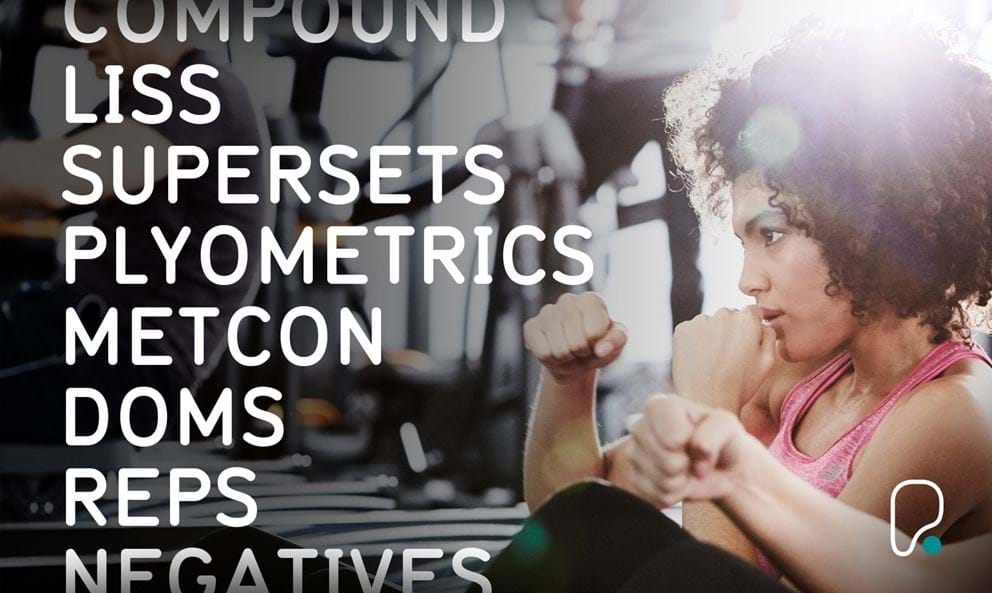Fitness terms explained

So you go to the gym. You may hear a lot of phrases thrown around that you haven’t a clue about. Are you doing a HIIT or LISS workout session? Maybe some plyometrics? Some supersets? Negatives? Or compound exercises? Are you feeling DOMS? What do these words even mean?
It can be a bit confusing and overwhelming at first! Once you know the lingo, however, it’s not all that bad. You're probably doing some of the above without even realising! Here are the most common fitness terms explained so you can become an expert in gym lingo in no time:
Reps
Short for repetitions! This word is usually used for weighted exercise where you perform a certain amount of repetitions, say 12 reps for example to complete one set.
HIIT
Short for high intensity interval training: a method of training that is essentially periods of maximal efforts with rest in-between - guaranteed to get your heart pumping. For example; 30 seconds sprint, 30 seconds rest on the treadmill, repeated for a number of times.
LISS
Short for low intensity steady state, so basically the opposite to HIIT. LISS is a method of training which is sub-maximal, slow and contains no rest. An example would be a 40 minute run on the treadmill. There is debate as to whether HIIT or LISS is best for fat loss but it’s best to do what you enjoy the most!
Plyometrics
A type of training usually done by athletes to help them jump higher or sprint faster. This training method usually consists of jumping and bounding where your time in contact with the floor is minimal.
Supersets
This is simply doing one weighted exercise into another with no rest in between. A good example would be press ups straight into bicep curls. The two exercises usually use opposing muscle groups but can be done using the same muscle group to really induce fatigue.
Giant sets
This is the same as supersets but usually contains 4 or more exercises completed in a row without rest.
Drop sets
Performing a set amount of reps on a weighted exercise (usually until failure), then without rest, dropping the weight and doing another set of around the same reps. This can be done multiple times in a row to really fatigue a muscle.
Negatives
This is doing one portion of a repetition. A negative is usually the lowering portion of a movement or where a muscle is being lengthened. This really tears muscle fibres and can be used to help build some serious size! To give it a go with some bicep curls, keep your form strict and pick a weight you can’t curl up. Get a friend to help you lift it up and lower it down over 6 seconds. Try 8 reps for 4 sets.
Compound
A compound exercise or movement is one that involves more than one muscle group. A squat for example is a compound exercise as you work the glutes, quads, hamstrings and core to name a few. A bicep curl on the other hand would be classed as an isolation exercise as it only involves one muscle - the biceps.
DOMS
This stands for delayed onset muscle soreness. This is the sore feeling that appears between 24-48hrs after a workout. In simple terms it is essentially inflammation of muscle tissue and the connective tissue surrounding it. You'll usually get DOMS if you do something new or do more of something than you have done before. A common misconception is that you need to be sore post workout to be improving but it’s not entirely true as research has shown no link between being sore and having a greater increase in size or strength of a muscle.
Metcon
Short for metabolic conditioning. This is basically a fancy word for cardio. However, a metcon will usually be intense as it is designed to boost your metabolism.
BCAA
This stands for branch chain amino acids. This is usually taken as a supplement to help increase muscle growth and is essentially the building blocks of protein.
Now that you know what these words mean, you can step into the gym without having to feel confused, and find out for yourself which training style you enjoy most!
Written by



